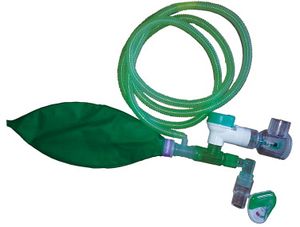Manual Hyperinflation: Difference between revisions
(created the content to the page) |
mNo edit summary |
||
| Line 106: | Line 106: | ||
[[Category:Respiratory Disease - Interventions]] | [[Category:Respiratory Disease - Interventions]] | ||
[[Category:Respiratory Disease - Interventions]] | [[Category:Respiratory Disease - Interventions]] | ||
<div class="editorbox"> '''Original Editor '''- [[User:User Name|Sarah Popperwell]] '''Top Contributors''' - {{Special:Contributors/{{FULLPAGENAME}}}}</div> | |||
Revision as of 10:17, 20 September 2020
Introduction[edit | edit source]
Manual hyperinflation also known as manual ventilation or ‘bagging’, is a technique used by respiratory physiotherapists in the management of ventilated patients or patients self-ventilating through a tracheostomy. Manual hyperinflation is used to increase lung volumes and aid secretion clearance when used in conjunction with suctioning[1]. Manual hyperinflation involves the use of a manual
resuscitator bag (MRB) connected to oxygen to provide a slow, deep inspiratory breath followed by an inspiratory pause of 1-2 seconds, and a rapid release of the resuscitation bag [2].
Mechanism of action[edit | edit source]
To increase volume[edit | edit source]
Manual hyperinflation is used to manage atelectasis. The mechanism it is thought to work is by increasing alveolar recruitment. The squeezing of the resuscitation bag increases the baseline tidal volumes during inspiration by approximately 1L [3]. This increase in tidal volume plus inspiratory hold allows time for alveoli and collateral airways to open, thereby increasing lung compliance and reducing atelactasis [4].
For secretion clearance[edit | edit source]
MH not only increases the tidal volume but the quick release of the resuscitation bag increases the elastic recoil of the lung and therefore increases the expiratory flow rate. The expiratory flow rate is necessary to mobilise secretions.
The mechanism for how this works can be explained by the engineering concept of two-phase gas-liquid flow; moving gas in a tube transfers momentum to the stationary liquid, and occurs when the expiratory flow rate is greater than inspiratory flow rate[5][4][1]. The use of a pressure manometer is recommended to ensure this expiratory flow bias [1].
Once the secretions have been mobilised, suctioning is often used to clear them from the patient.
Absolute Contraindications[edit | edit source]
- Undrained pneumothorax
- Severe bronchospasm
- Head injury with ICP > 25mmHg
- Severe arterial hypotension
- High peak end inspiratory pressure (PEEP) ventilation and PEEP dependency
- Nitric Oxide ventilation
- High Frequency Oscillation Ventilation
Relative Contraindications[edit | edit source]
Note: These relative contraindications are for ‘therapeutic’ mh
| · Cardiovascular (CVS) instability/arrhythmias | Compromised venous return- further increases effort required to maintain adequate tissue perfusion |
| · Acute Respiratory Distress Syndrome (ARDS) | Increases risk of pneumothorax/barotrauma
NB! This does not preclude the use of the MRB in resuscitation situations in this patient group |
| · Severe exacerbation Chronic Obstructive Pulmonary Disease (COPD) / Bronchospasm | Increased airway pressure will increase airway irritation and inflammatory response |
| · High PEEP (> 10cmH2O) | The break in the circuit will cause loss of PEEP and can de-recruit lung |
| · Raised intracranial pressure (ICP) | Increased intrathoracic pressure reduces mean arterial pressure which can compromise cerebral perfusion pressure |
| · Proximal Tumor/obstruction | Risk of dislodging or causing trauma |
| · Emphysematous Bullae | Increases risk of pneumothorax |
| · Recent lung surgery e.g. lobectomy/pneumonectomy | High airway pressure may cause trauma/pneumothorax. Check with surgeons regarding stump pressure. |
| · Hypotension (Systolic <80) | Increased positive pressure in thoracic cavity compromises venous return – reduces cardiac output |
| · Patients dependent on hypoxic drive | High levels of O2 being delivered/increased PaO2 levels may reduce drive to breathe |
| · Acute Head Injury | As for raised ICP |
| · Unexplained Haemoptysis | May be indicative of acute trauma to the lung parenchyma |
| · High respiratory rate | Difficult to co-ordinate the technique |
| · Subcutaneous Emphysema | May indicate the presence of a pneumothorax |
Technique[edit | edit source]
https://www.youtube.com/watch?v=209txhJW3iM
Be the first to edit this page and have your name permanently included as the original editor, see the editing pages tutorial for help.
- ↑ 1.0 1.1 1.2 Volpe, M. S., Naves, J. M., Ribeiro, G. G., Ruas, G., & Tucci, M. R. (2018). Effects of manual hyperinflation, clinical practice versus expert recommendation, on displacement of mucus simulant: A laboratory study. PLoS ONE, 13(2), 1–11.
- ↑ Lemes, D. A., Zin, W. A., & Guimarães, F. S. (2009). Hyperinflation using pressure support ventilation improves secretion clearance and respiratory mechanics in ventilated patients with pulmonary infection: A randomised crossover trial. Australian Journal of Physiotherapy, 55(4), 249–254.
- ↑ Frank, U., Frank, K., & Zimmermann, H. (2015). Effects of respiratory therapy (bagging) on respiratory function, swallowing frequency and vigilance in tracheotomized patients in early neurorehabilitation. Pneumologie, 69(07), 394-399.
- ↑ 4.0 4.1 Bennett, B. G., Thomas, P., & Ntoumenopoulos, G. (2015). Effect of Inspiratory Time and Lung Compliance on Flow Bias Generated During Manual Hyperinflation: A Bench Study. Respiratory Care, 60(10), 1449–1458.
- ↑ Maxwell, L., & Ellis, E. (1998). Secretion clearance by manual hyperinflation: Possible mechanisms. Physiotherapy Theory and Practice, 14(4), 189–197.







